Wireless Networking Concepts Report
VerifiedAdded on 2020/02/24
|11
|1835
|39
Report
AI Summary
The report delves into the concept of wireless networking, focusing on various types of antennas including horn, Yagi-Uda, helical, and aperture antennas. It discusses their applications, strengths, and weaknesses, while highlighting the future potential of the helical antenna in communication systems. The report concludes that different antennas serve specific roles in communication, with the helical antenna poised to be a dominant player in the future.
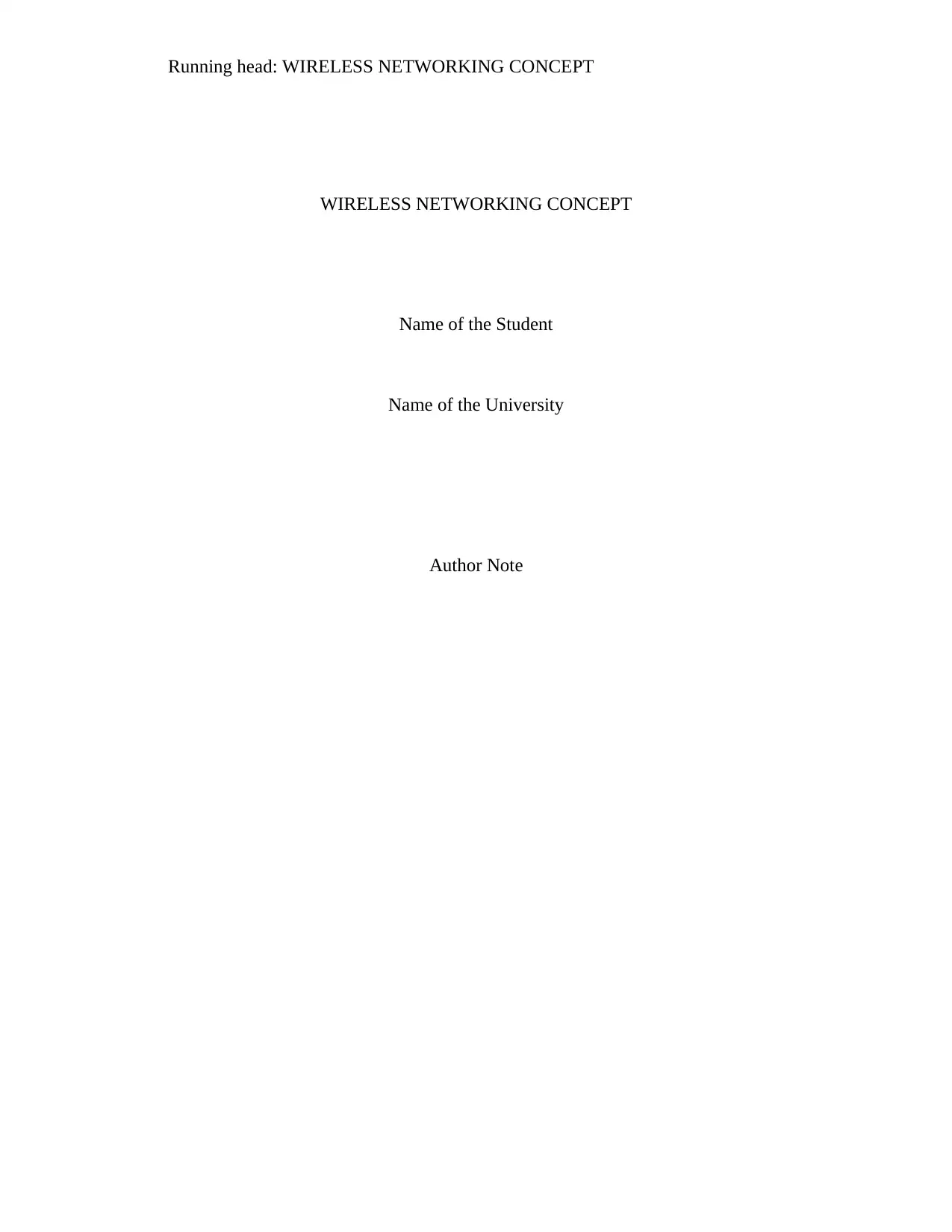
Running head: WIRELESS NETWORKING CONCEPT
WIRELESS NETWORKING CONCEPT
Name of the Student
Name of the University
Author Note
WIRELESS NETWORKING CONCEPT
Name of the Student
Name of the University
Author Note
Paraphrase This Document
Need a fresh take? Get an instant paraphrase of this document with our AI Paraphraser
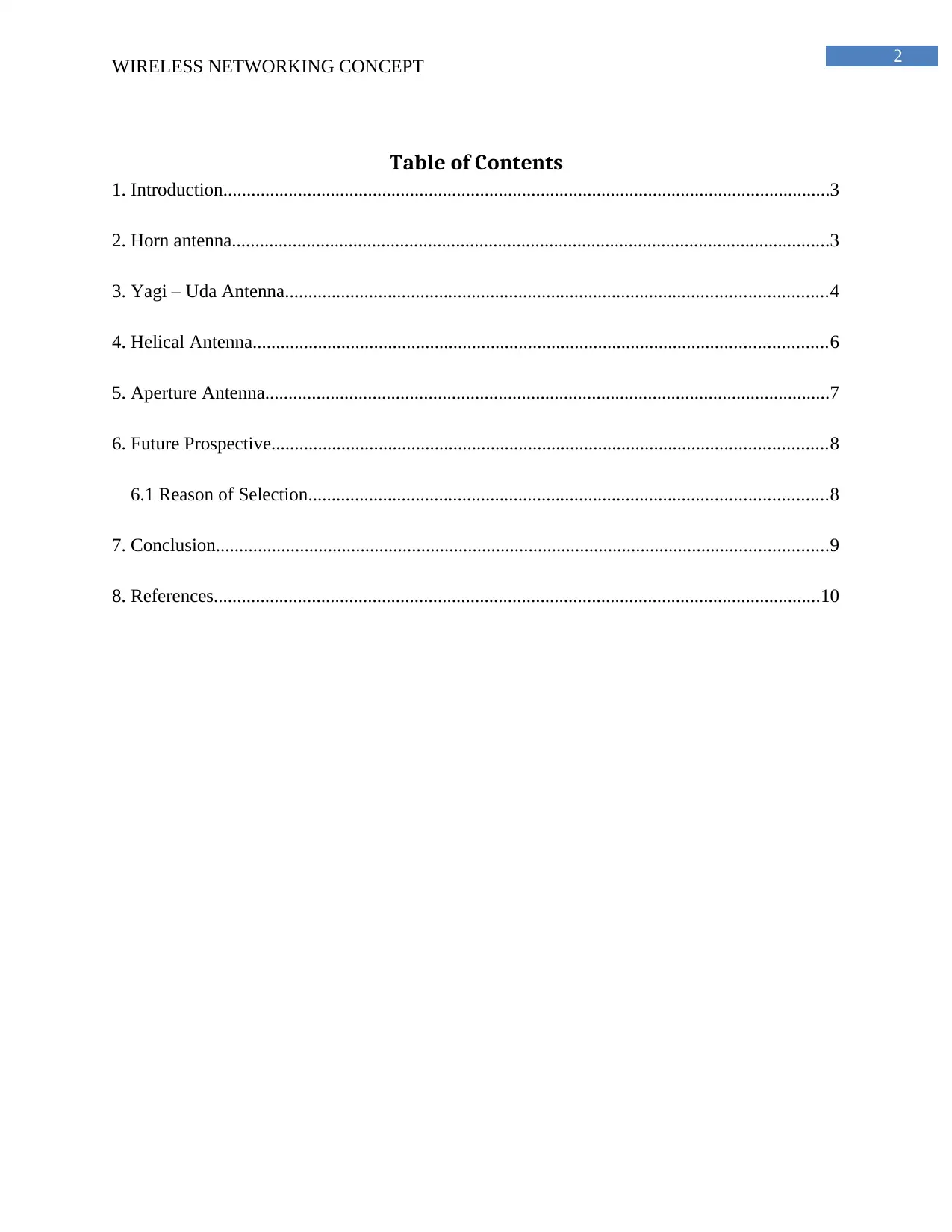
2
WIRELESS NETWORKING CONCEPT
Table of Contents
1. Introduction..................................................................................................................................3
2. Horn antenna................................................................................................................................3
3. Yagi – Uda Antenna....................................................................................................................4
4. Helical Antenna...........................................................................................................................6
5. Aperture Antenna.........................................................................................................................7
6. Future Prospective.......................................................................................................................8
6.1 Reason of Selection...............................................................................................................8
7. Conclusion...................................................................................................................................9
8. References..................................................................................................................................10
WIRELESS NETWORKING CONCEPT
Table of Contents
1. Introduction..................................................................................................................................3
2. Horn antenna................................................................................................................................3
3. Yagi – Uda Antenna....................................................................................................................4
4. Helical Antenna...........................................................................................................................6
5. Aperture Antenna.........................................................................................................................7
6. Future Prospective.......................................................................................................................8
6.1 Reason of Selection...............................................................................................................8
7. Conclusion...................................................................................................................................9
8. References..................................................................................................................................10
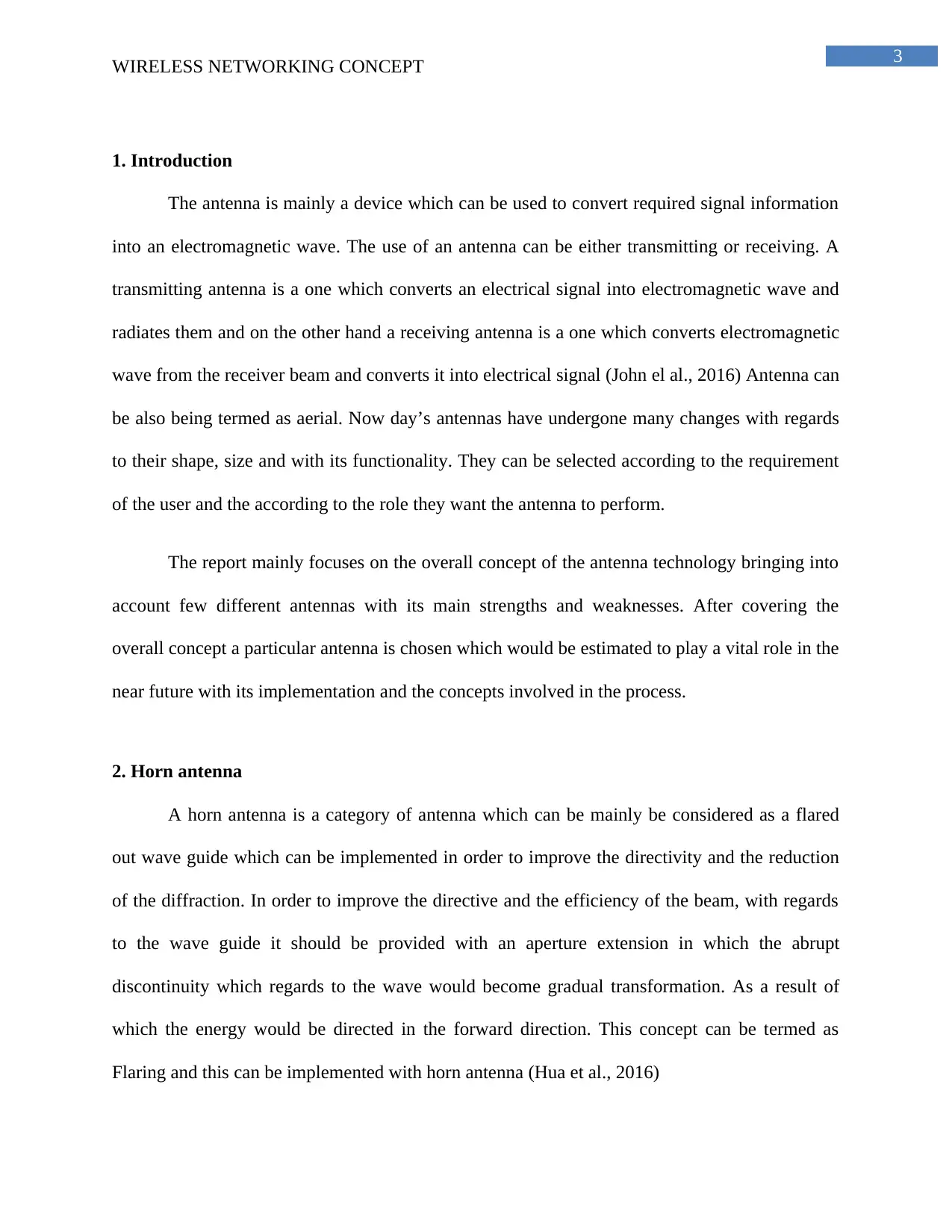
3
WIRELESS NETWORKING CONCEPT
1. Introduction
The antenna is mainly a device which can be used to convert required signal information
into an electromagnetic wave. The use of an antenna can be either transmitting or receiving. A
transmitting antenna is a one which converts an electrical signal into electromagnetic wave and
radiates them and on the other hand a receiving antenna is a one which converts electromagnetic
wave from the receiver beam and converts it into electrical signal (John el al., 2016) Antenna can
be also being termed as aerial. Now day’s antennas have undergone many changes with regards
to their shape, size and with its functionality. They can be selected according to the requirement
of the user and the according to the role they want the antenna to perform.
The report mainly focuses on the overall concept of the antenna technology bringing into
account few different antennas with its main strengths and weaknesses. After covering the
overall concept a particular antenna is chosen which would be estimated to play a vital role in the
near future with its implementation and the concepts involved in the process.
2. Horn antenna
A horn antenna is a category of antenna which can be mainly be considered as a flared
out wave guide which can be implemented in order to improve the directivity and the reduction
of the diffraction. In order to improve the directive and the efficiency of the beam, with regards
to the wave guide it should be provided with an aperture extension in which the abrupt
discontinuity which regards to the wave would become gradual transformation. As a result of
which the energy would be directed in the forward direction. This concept can be termed as
Flaring and this can be implemented with horn antenna (Hua et al., 2016)
WIRELESS NETWORKING CONCEPT
1. Introduction
The antenna is mainly a device which can be used to convert required signal information
into an electromagnetic wave. The use of an antenna can be either transmitting or receiving. A
transmitting antenna is a one which converts an electrical signal into electromagnetic wave and
radiates them and on the other hand a receiving antenna is a one which converts electromagnetic
wave from the receiver beam and converts it into electrical signal (John el al., 2016) Antenna can
be also being termed as aerial. Now day’s antennas have undergone many changes with regards
to their shape, size and with its functionality. They can be selected according to the requirement
of the user and the according to the role they want the antenna to perform.
The report mainly focuses on the overall concept of the antenna technology bringing into
account few different antennas with its main strengths and weaknesses. After covering the
overall concept a particular antenna is chosen which would be estimated to play a vital role in the
near future with its implementation and the concepts involved in the process.
2. Horn antenna
A horn antenna is a category of antenna which can be mainly be considered as a flared
out wave guide which can be implemented in order to improve the directivity and the reduction
of the diffraction. In order to improve the directive and the efficiency of the beam, with regards
to the wave guide it should be provided with an aperture extension in which the abrupt
discontinuity which regards to the wave would become gradual transformation. As a result of
which the energy would be directed in the forward direction. This concept can be termed as
Flaring and this can be implemented with horn antenna (Hua et al., 2016)
⊘ This is a preview!⊘
Do you want full access?
Subscribe today to unlock all pages.

Trusted by 1+ million students worldwide
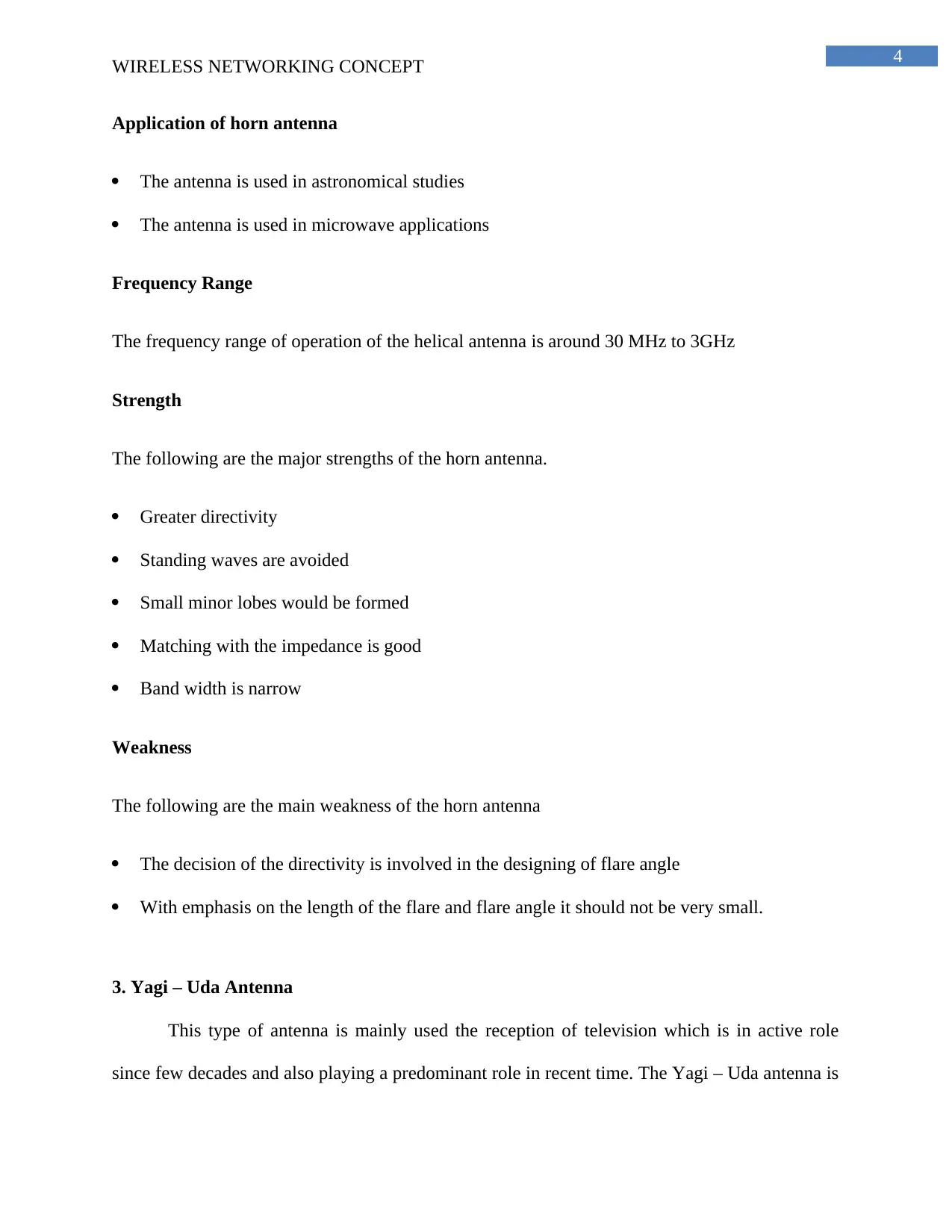
4
WIRELESS NETWORKING CONCEPT
Application of horn antenna
The antenna is used in astronomical studies
The antenna is used in microwave applications
Frequency Range
The frequency range of operation of the helical antenna is around 30 MHz to 3GHz
Strength
The following are the major strengths of the horn antenna.
Greater directivity
Standing waves are avoided
Small minor lobes would be formed
Matching with the impedance is good
Band width is narrow
Weakness
The following are the main weakness of the horn antenna
The decision of the directivity is involved in the designing of flare angle
With emphasis on the length of the flare and flare angle it should not be very small.
3. Yagi – Uda Antenna
This type of antenna is mainly used the reception of television which is in active role
since few decades and also playing a predominant role in recent time. The Yagi – Uda antenna is
WIRELESS NETWORKING CONCEPT
Application of horn antenna
The antenna is used in astronomical studies
The antenna is used in microwave applications
Frequency Range
The frequency range of operation of the helical antenna is around 30 MHz to 3GHz
Strength
The following are the major strengths of the horn antenna.
Greater directivity
Standing waves are avoided
Small minor lobes would be formed
Matching with the impedance is good
Band width is narrow
Weakness
The following are the main weakness of the horn antenna
The decision of the directivity is involved in the designing of flare angle
With emphasis on the length of the flare and flare angle it should not be very small.
3. Yagi – Uda Antenna
This type of antenna is mainly used the reception of television which is in active role
since few decades and also playing a predominant role in recent time. The Yagi – Uda antenna is
Paraphrase This Document
Need a fresh take? Get an instant paraphrase of this document with our AI Paraphraser
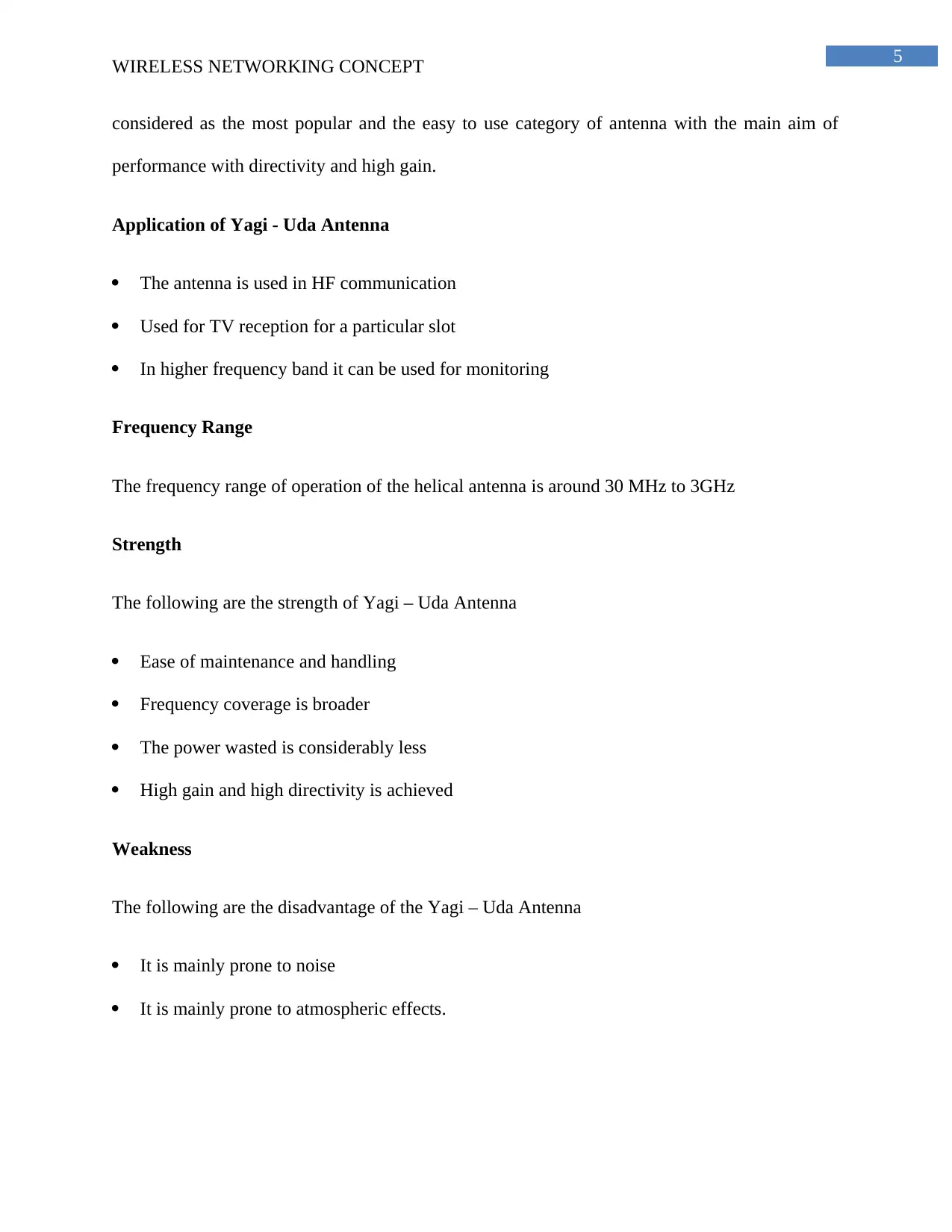
5
WIRELESS NETWORKING CONCEPT
considered as the most popular and the easy to use category of antenna with the main aim of
performance with directivity and high gain.
Application of Yagi - Uda Antenna
The antenna is used in HF communication
Used for TV reception for a particular slot
In higher frequency band it can be used for monitoring
Frequency Range
The frequency range of operation of the helical antenna is around 30 MHz to 3GHz
Strength
The following are the strength of Yagi – Uda Antenna
Ease of maintenance and handling
Frequency coverage is broader
The power wasted is considerably less
High gain and high directivity is achieved
Weakness
The following are the disadvantage of the Yagi – Uda Antenna
It is mainly prone to noise
It is mainly prone to atmospheric effects.
WIRELESS NETWORKING CONCEPT
considered as the most popular and the easy to use category of antenna with the main aim of
performance with directivity and high gain.
Application of Yagi - Uda Antenna
The antenna is used in HF communication
Used for TV reception for a particular slot
In higher frequency band it can be used for monitoring
Frequency Range
The frequency range of operation of the helical antenna is around 30 MHz to 3GHz
Strength
The following are the strength of Yagi – Uda Antenna
Ease of maintenance and handling
Frequency coverage is broader
The power wasted is considerably less
High gain and high directivity is achieved
Weakness
The following are the disadvantage of the Yagi – Uda Antenna
It is mainly prone to noise
It is mainly prone to atmospheric effects.
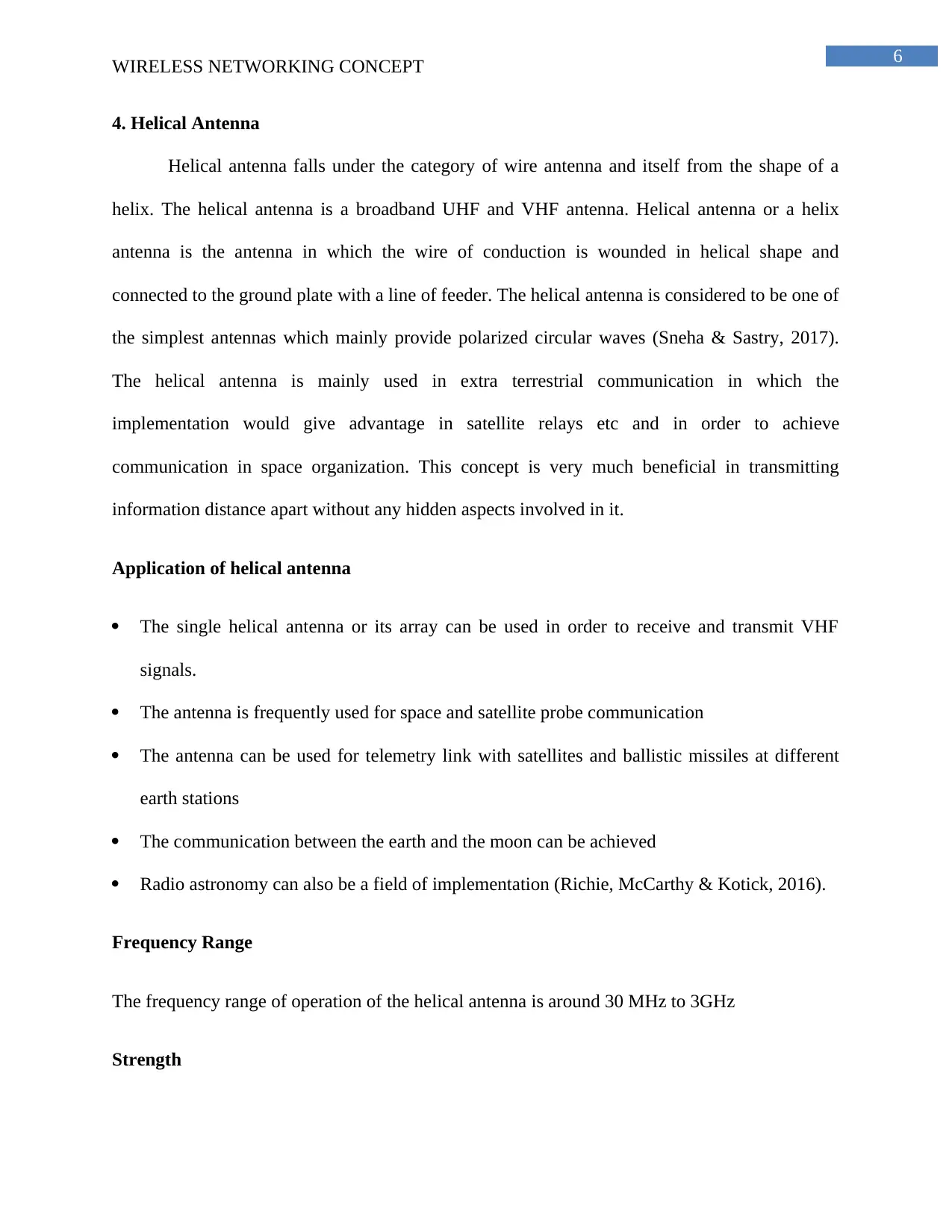
6
WIRELESS NETWORKING CONCEPT
4. Helical Antenna
Helical antenna falls under the category of wire antenna and itself from the shape of a
helix. The helical antenna is a broadband UHF and VHF antenna. Helical antenna or a helix
antenna is the antenna in which the wire of conduction is wounded in helical shape and
connected to the ground plate with a line of feeder. The helical antenna is considered to be one of
the simplest antennas which mainly provide polarized circular waves (Sneha & Sastry, 2017).
The helical antenna is mainly used in extra terrestrial communication in which the
implementation would give advantage in satellite relays etc and in order to achieve
communication in space organization. This concept is very much beneficial in transmitting
information distance apart without any hidden aspects involved in it.
Application of helical antenna
The single helical antenna or its array can be used in order to receive and transmit VHF
signals.
The antenna is frequently used for space and satellite probe communication
The antenna can be used for telemetry link with satellites and ballistic missiles at different
earth stations
The communication between the earth and the moon can be achieved
Radio astronomy can also be a field of implementation (Richie, McCarthy & Kotick, 2016).
Frequency Range
The frequency range of operation of the helical antenna is around 30 MHz to 3GHz
Strength
WIRELESS NETWORKING CONCEPT
4. Helical Antenna
Helical antenna falls under the category of wire antenna and itself from the shape of a
helix. The helical antenna is a broadband UHF and VHF antenna. Helical antenna or a helix
antenna is the antenna in which the wire of conduction is wounded in helical shape and
connected to the ground plate with a line of feeder. The helical antenna is considered to be one of
the simplest antennas which mainly provide polarized circular waves (Sneha & Sastry, 2017).
The helical antenna is mainly used in extra terrestrial communication in which the
implementation would give advantage in satellite relays etc and in order to achieve
communication in space organization. This concept is very much beneficial in transmitting
information distance apart without any hidden aspects involved in it.
Application of helical antenna
The single helical antenna or its array can be used in order to receive and transmit VHF
signals.
The antenna is frequently used for space and satellite probe communication
The antenna can be used for telemetry link with satellites and ballistic missiles at different
earth stations
The communication between the earth and the moon can be achieved
Radio astronomy can also be a field of implementation (Richie, McCarthy & Kotick, 2016).
Frequency Range
The frequency range of operation of the helical antenna is around 30 MHz to 3GHz
Strength
⊘ This is a preview!⊘
Do you want full access?
Subscribe today to unlock all pages.

Trusted by 1+ million students worldwide
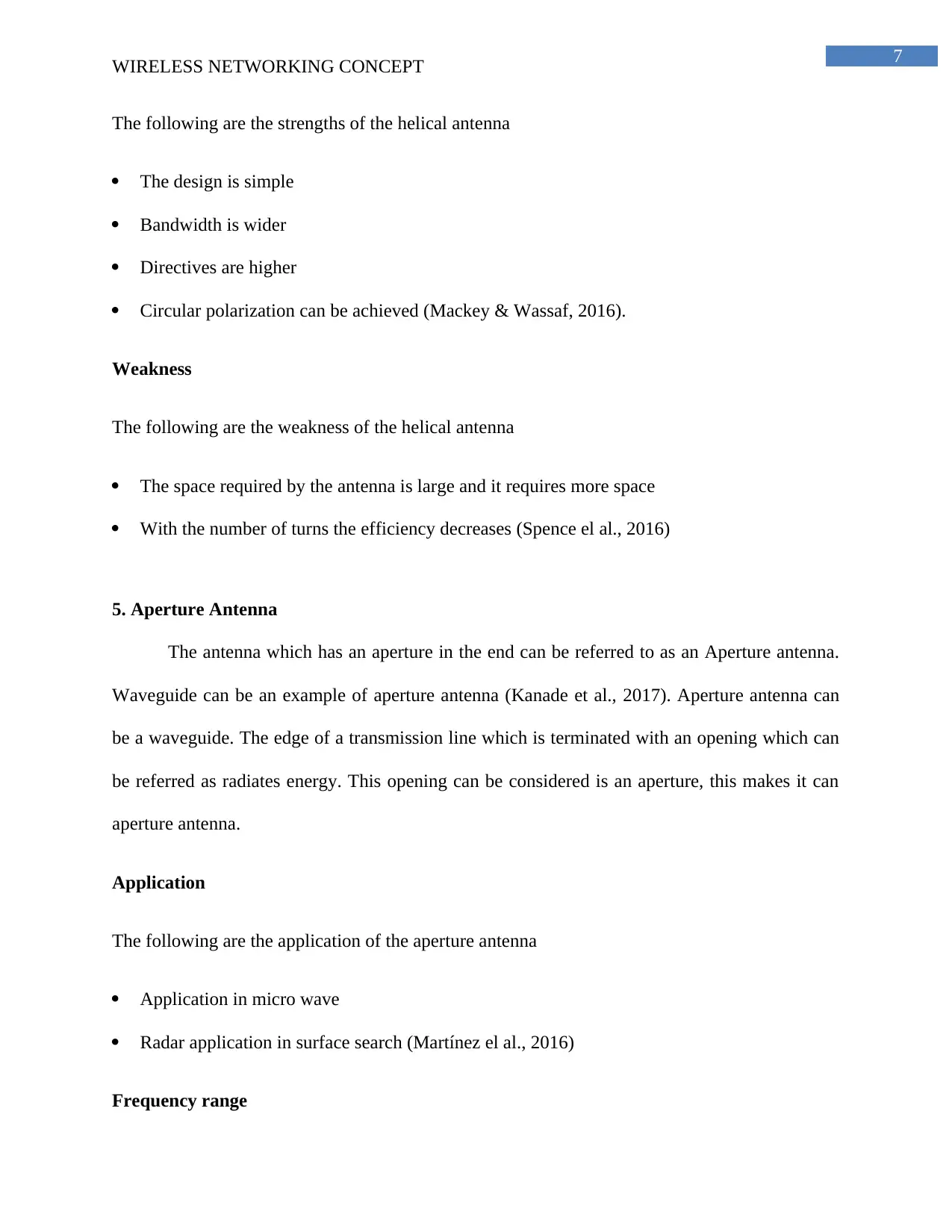
7
WIRELESS NETWORKING CONCEPT
The following are the strengths of the helical antenna
The design is simple
Bandwidth is wider
Directives are higher
Circular polarization can be achieved (Mackey & Wassaf, 2016).
Weakness
The following are the weakness of the helical antenna
The space required by the antenna is large and it requires more space
With the number of turns the efficiency decreases (Spence el al., 2016)
5. Aperture Antenna
The antenna which has an aperture in the end can be referred to as an Aperture antenna.
Waveguide can be an example of aperture antenna (Kanade et al., 2017). Aperture antenna can
be a waveguide. The edge of a transmission line which is terminated with an opening which can
be referred as radiates energy. This opening can be considered is an aperture, this makes it can
aperture antenna.
Application
The following are the application of the aperture antenna
Application in micro wave
Radar application in surface search (Martínez el al., 2016)
Frequency range
WIRELESS NETWORKING CONCEPT
The following are the strengths of the helical antenna
The design is simple
Bandwidth is wider
Directives are higher
Circular polarization can be achieved (Mackey & Wassaf, 2016).
Weakness
The following are the weakness of the helical antenna
The space required by the antenna is large and it requires more space
With the number of turns the efficiency decreases (Spence el al., 2016)
5. Aperture Antenna
The antenna which has an aperture in the end can be referred to as an Aperture antenna.
Waveguide can be an example of aperture antenna (Kanade et al., 2017). Aperture antenna can
be a waveguide. The edge of a transmission line which is terminated with an opening which can
be referred as radiates energy. This opening can be considered is an aperture, this makes it can
aperture antenna.
Application
The following are the application of the aperture antenna
Application in micro wave
Radar application in surface search (Martínez el al., 2016)
Frequency range
Paraphrase This Document
Need a fresh take? Get an instant paraphrase of this document with our AI Paraphraser
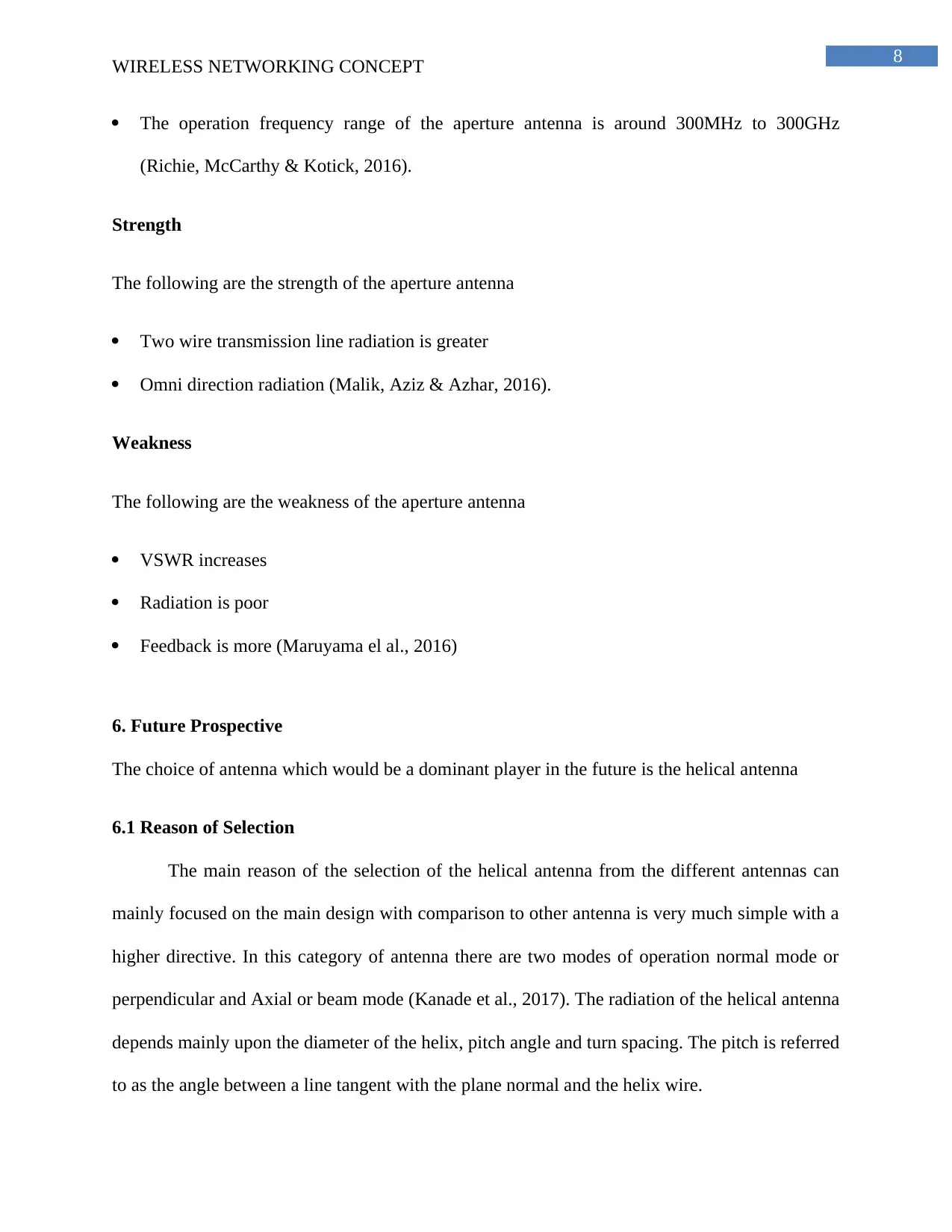
8
WIRELESS NETWORKING CONCEPT
The operation frequency range of the aperture antenna is around 300MHz to 300GHz
(Richie, McCarthy & Kotick, 2016).
Strength
The following are the strength of the aperture antenna
Two wire transmission line radiation is greater
Omni direction radiation (Malik, Aziz & Azhar, 2016).
Weakness
The following are the weakness of the aperture antenna
VSWR increases
Radiation is poor
Feedback is more (Maruyama el al., 2016)
6. Future Prospective
The choice of antenna which would be a dominant player in the future is the helical antenna
6.1 Reason of Selection
The main reason of the selection of the helical antenna from the different antennas can
mainly focused on the main design with comparison to other antenna is very much simple with a
higher directive. In this category of antenna there are two modes of operation normal mode or
perpendicular and Axial or beam mode (Kanade et al., 2017). The radiation of the helical antenna
depends mainly upon the diameter of the helix, pitch angle and turn spacing. The pitch is referred
to as the angle between a line tangent with the plane normal and the helix wire.
WIRELESS NETWORKING CONCEPT
The operation frequency range of the aperture antenna is around 300MHz to 300GHz
(Richie, McCarthy & Kotick, 2016).
Strength
The following are the strength of the aperture antenna
Two wire transmission line radiation is greater
Omni direction radiation (Malik, Aziz & Azhar, 2016).
Weakness
The following are the weakness of the aperture antenna
VSWR increases
Radiation is poor
Feedback is more (Maruyama el al., 2016)
6. Future Prospective
The choice of antenna which would be a dominant player in the future is the helical antenna
6.1 Reason of Selection
The main reason of the selection of the helical antenna from the different antennas can
mainly focused on the main design with comparison to other antenna is very much simple with a
higher directive. In this category of antenna there are two modes of operation normal mode or
perpendicular and Axial or beam mode (Kanade et al., 2017). The radiation of the helical antenna
depends mainly upon the diameter of the helix, pitch angle and turn spacing. The pitch is referred
to as the angle between a line tangent with the plane normal and the helix wire.
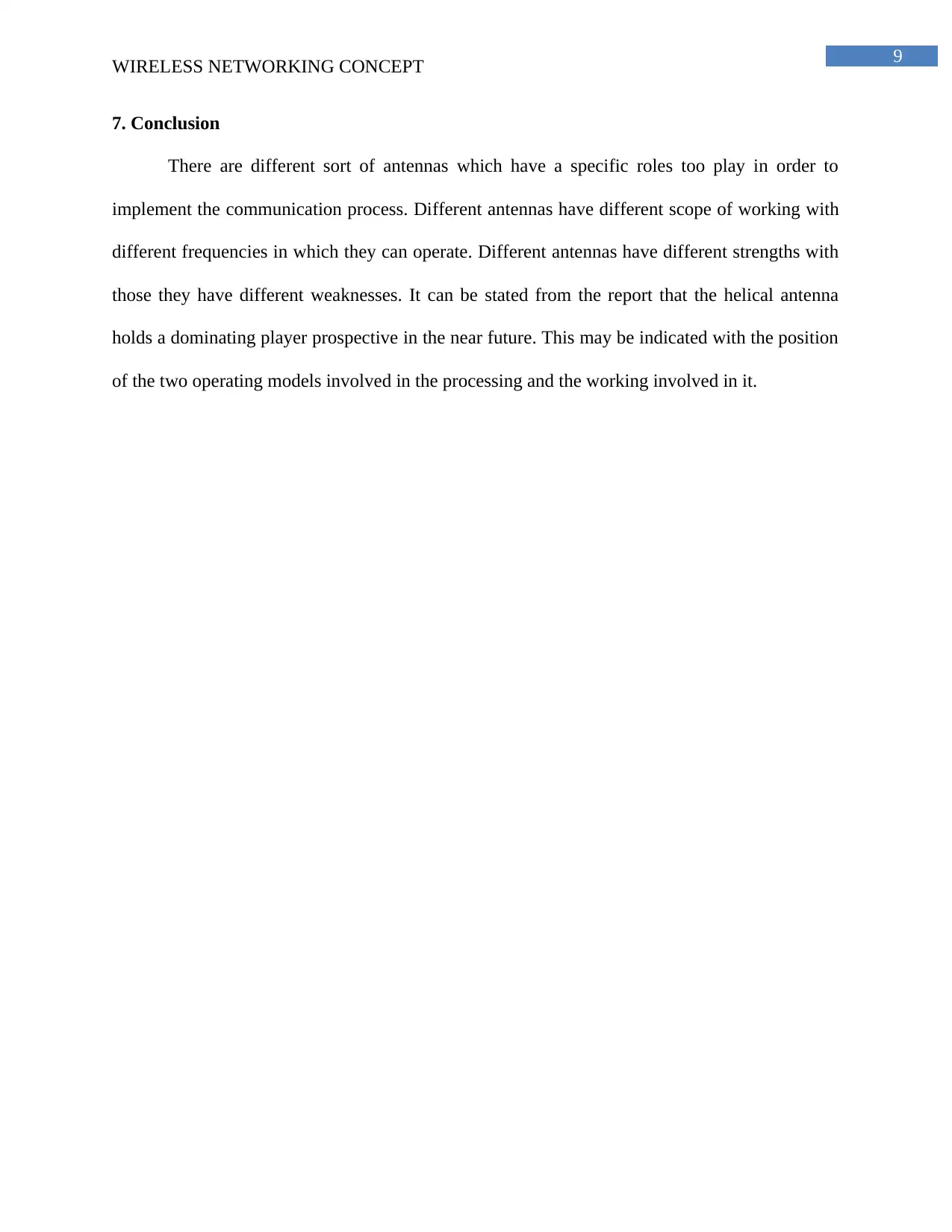
9
WIRELESS NETWORKING CONCEPT
7. Conclusion
There are different sort of antennas which have a specific roles too play in order to
implement the communication process. Different antennas have different scope of working with
different frequencies in which they can operate. Different antennas have different strengths with
those they have different weaknesses. It can be stated from the report that the helical antenna
holds a dominating player prospective in the near future. This may be indicated with the position
of the two operating models involved in the processing and the working involved in it.
WIRELESS NETWORKING CONCEPT
7. Conclusion
There are different sort of antennas which have a specific roles too play in order to
implement the communication process. Different antennas have different scope of working with
different frequencies in which they can operate. Different antennas have different strengths with
those they have different weaknesses. It can be stated from the report that the helical antenna
holds a dominating player prospective in the near future. This may be indicated with the position
of the two operating models involved in the processing and the working involved in it.
⊘ This is a preview!⊘
Do you want full access?
Subscribe today to unlock all pages.

Trusted by 1+ million students worldwide
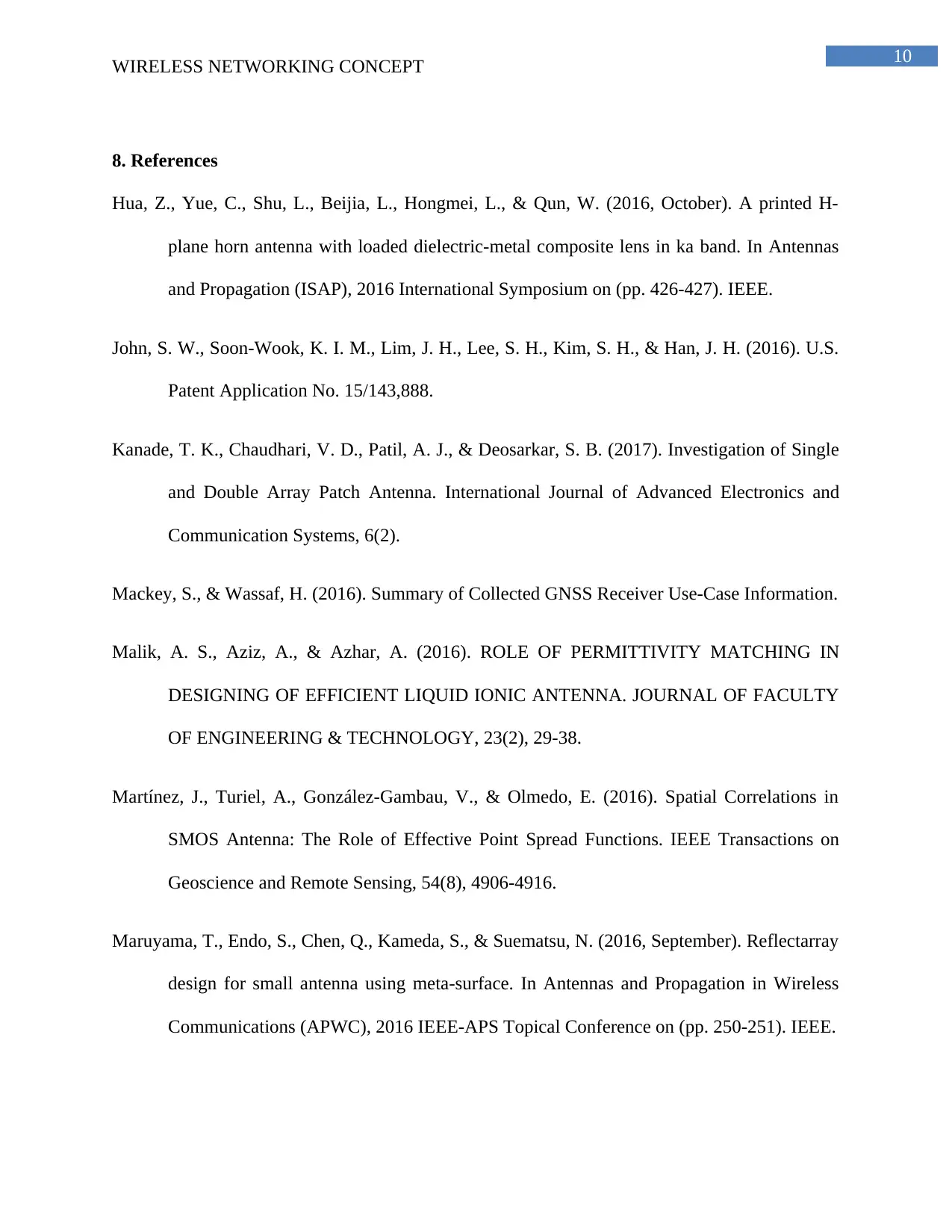
10
WIRELESS NETWORKING CONCEPT
8. References
Hua, Z., Yue, C., Shu, L., Beijia, L., Hongmei, L., & Qun, W. (2016, October). A printed H-
plane horn antenna with loaded dielectric-metal composite lens in ka band. In Antennas
and Propagation (ISAP), 2016 International Symposium on (pp. 426-427). IEEE.
John, S. W., Soon-Wook, K. I. M., Lim, J. H., Lee, S. H., Kim, S. H., & Han, J. H. (2016). U.S.
Patent Application No. 15/143,888.
Kanade, T. K., Chaudhari, V. D., Patil, A. J., & Deosarkar, S. B. (2017). Investigation of Single
and Double Array Patch Antenna. International Journal of Advanced Electronics and
Communication Systems, 6(2).
Mackey, S., & Wassaf, H. (2016). Summary of Collected GNSS Receiver Use-Case Information.
Malik, A. S., Aziz, A., & Azhar, A. (2016). ROLE OF PERMITTIVITY MATCHING IN
DESIGNING OF EFFICIENT LIQUID IONIC ANTENNA. JOURNAL OF FACULTY
OF ENGINEERING & TECHNOLOGY, 23(2), 29-38.
Martínez, J., Turiel, A., González-Gambau, V., & Olmedo, E. (2016). Spatial Correlations in
SMOS Antenna: The Role of Effective Point Spread Functions. IEEE Transactions on
Geoscience and Remote Sensing, 54(8), 4906-4916.
Maruyama, T., Endo, S., Chen, Q., Kameda, S., & Suematsu, N. (2016, September). Reflectarray
design for small antenna using meta-surface. In Antennas and Propagation in Wireless
Communications (APWC), 2016 IEEE-APS Topical Conference on (pp. 250-251). IEEE.
WIRELESS NETWORKING CONCEPT
8. References
Hua, Z., Yue, C., Shu, L., Beijia, L., Hongmei, L., & Qun, W. (2016, October). A printed H-
plane horn antenna with loaded dielectric-metal composite lens in ka band. In Antennas
and Propagation (ISAP), 2016 International Symposium on (pp. 426-427). IEEE.
John, S. W., Soon-Wook, K. I. M., Lim, J. H., Lee, S. H., Kim, S. H., & Han, J. H. (2016). U.S.
Patent Application No. 15/143,888.
Kanade, T. K., Chaudhari, V. D., Patil, A. J., & Deosarkar, S. B. (2017). Investigation of Single
and Double Array Patch Antenna. International Journal of Advanced Electronics and
Communication Systems, 6(2).
Mackey, S., & Wassaf, H. (2016). Summary of Collected GNSS Receiver Use-Case Information.
Malik, A. S., Aziz, A., & Azhar, A. (2016). ROLE OF PERMITTIVITY MATCHING IN
DESIGNING OF EFFICIENT LIQUID IONIC ANTENNA. JOURNAL OF FACULTY
OF ENGINEERING & TECHNOLOGY, 23(2), 29-38.
Martínez, J., Turiel, A., González-Gambau, V., & Olmedo, E. (2016). Spatial Correlations in
SMOS Antenna: The Role of Effective Point Spread Functions. IEEE Transactions on
Geoscience and Remote Sensing, 54(8), 4906-4916.
Maruyama, T., Endo, S., Chen, Q., Kameda, S., & Suematsu, N. (2016, September). Reflectarray
design for small antenna using meta-surface. In Antennas and Propagation in Wireless
Communications (APWC), 2016 IEEE-APS Topical Conference on (pp. 250-251). IEEE.
Paraphrase This Document
Need a fresh take? Get an instant paraphrase of this document with our AI Paraphraser
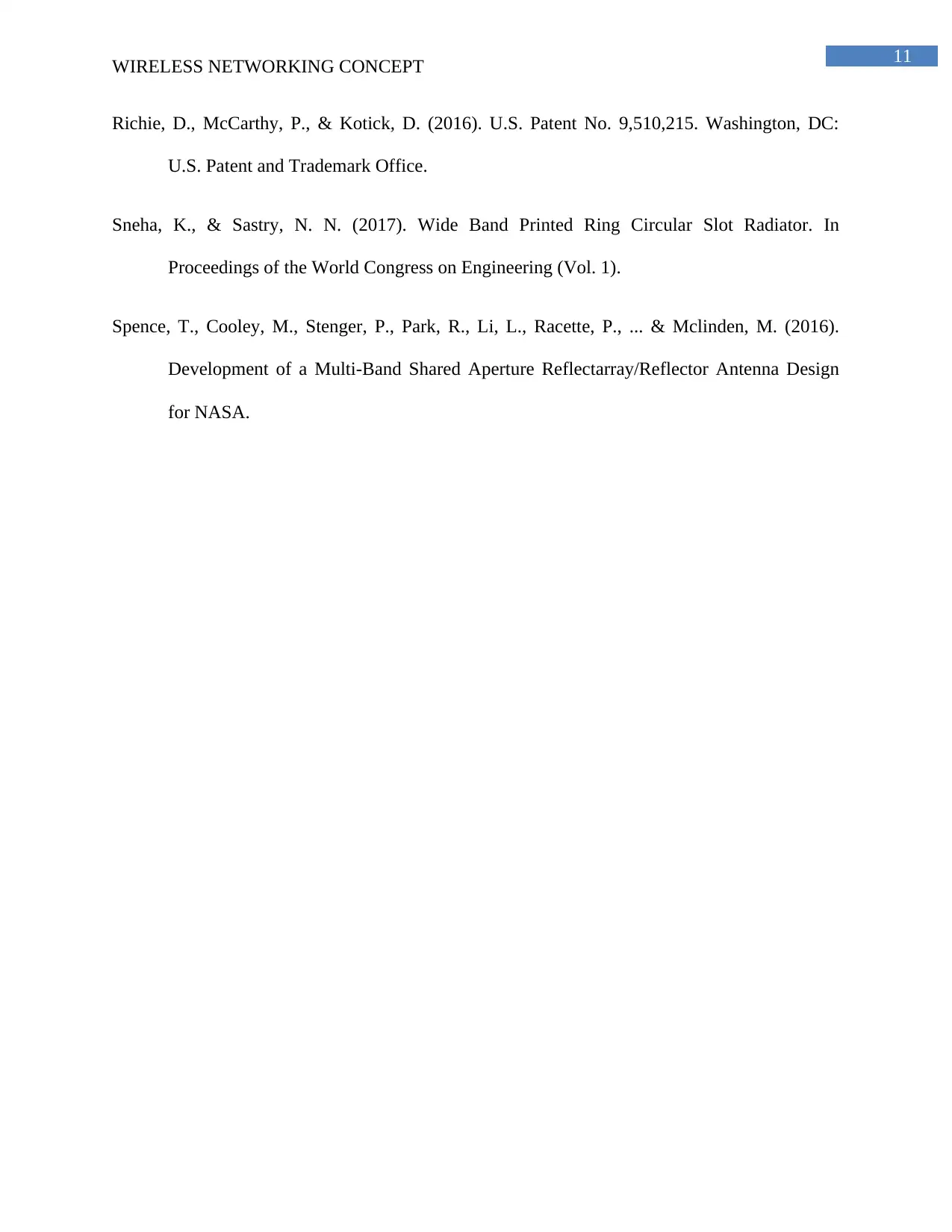
11
WIRELESS NETWORKING CONCEPT
Richie, D., McCarthy, P., & Kotick, D. (2016). U.S. Patent No. 9,510,215. Washington, DC:
U.S. Patent and Trademark Office.
Sneha, K., & Sastry, N. N. (2017). Wide Band Printed Ring Circular Slot Radiator. In
Proceedings of the World Congress on Engineering (Vol. 1).
Spence, T., Cooley, M., Stenger, P., Park, R., Li, L., Racette, P., ... & Mclinden, M. (2016).
Development of a Multi-Band Shared Aperture Reflectarray/Reflector Antenna Design
for NASA.
WIRELESS NETWORKING CONCEPT
Richie, D., McCarthy, P., & Kotick, D. (2016). U.S. Patent No. 9,510,215. Washington, DC:
U.S. Patent and Trademark Office.
Sneha, K., & Sastry, N. N. (2017). Wide Band Printed Ring Circular Slot Radiator. In
Proceedings of the World Congress on Engineering (Vol. 1).
Spence, T., Cooley, M., Stenger, P., Park, R., Li, L., Racette, P., ... & Mclinden, M. (2016).
Development of a Multi-Band Shared Aperture Reflectarray/Reflector Antenna Design
for NASA.
1 out of 11
Related Documents
Your All-in-One AI-Powered Toolkit for Academic Success.
+13062052269
info@desklib.com
Available 24*7 on WhatsApp / Email
![[object Object]](/_next/static/media/star-bottom.7253800d.svg)
Unlock your academic potential
Copyright © 2020–2025 A2Z Services. All Rights Reserved. Developed and managed by ZUCOL.




